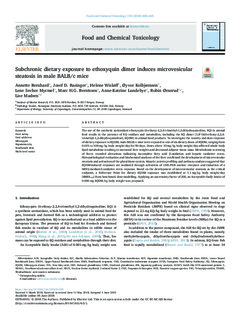| dc.contributor.author | Bernhard, Annette | |
| dc.contributor.author | Rasinger, Josef Daniel | |
| dc.contributor.author | Wisløff, Helene | |
| dc.contributor.author | Kolbjørnsen, Øyvor | |
| dc.contributor.author | Myrmel, Lene Secher | |
| dc.contributor.author | Berntssen, Marc | |
| dc.contributor.author | Lundebye, Anne-Katrine | |
| dc.contributor.author | Ørnsrud, Robin | |
| dc.contributor.author | Madsen, Lise | |
| dc.date.accessioned | 2018-09-10T09:03:46Z | |
| dc.date.available | 2018-09-10T09:03:46Z | |
| dc.date.created | 2018-07-12T12:53:32Z | |
| dc.date.issued | 2018 | |
| dc.identifier.citation | Food and Chemical Toxicology. 2018, 118 608-625. | nb_NO |
| dc.identifier.issn | 0278-6915 | |
| dc.identifier.uri | http://hdl.handle.net/11250/2561670 | |
| dc.description.abstract | The use of the synthetic antioxidant ethoxyquin (6-ethoxy-2,2,4-trimethyl-1,2-dihydroquinoline; EQ) in animal feed results in the presence of EQ residues and metabolites, including the EQ dimer (1,8′-bi(6-ethoxy-2,2,4-trimethyl-1,2-dihydroquinoline); EQDM) in animal food products. To investigate the toxicity and dose-response of dietary exposure to EQDM, male BALB/c mice were exposed to one of six dietary doses of EQDM, ranging from 0.015 to 518 mg/kg body weight/day for 90 days. Doses above 10 mg/kg body weight/day affected whole body lipid metabolism resulting in increased liver weights and decreased adipose tissue mass. Metabolomic screening of livers revealed alterations indicating incomplete fatty acid β-oxidation and hepatic oxidative stress. Histopathological evaluation and biochemical analyses of the liver confirmed the development of microvesicular steatosis and activation of the glutathione system. Hepatic protein profiling and pathway analyses suggested that EQDM-induced responses are mediated through activation of CAR/PXR nuclear receptors and induction of a NRF2-mediated oxidative stress response. Based on the development of microvesicular steatosis as the critical endpoint, a Reference Point for dietary EQDM exposure was established at 1.1 mg/kg body weight/day (BMDL10) from benchmark dose modelling. Applying an uncertainty factor of 200, an Acceptable Daily Intake of 0.006 mg EQDM/kg body weight was proposed. | nb_NO |
| dc.language.iso | eng | nb_NO |
| dc.title | Subchronic dietary exposure to ethoxyquin dimer induces microvesicular steatosis in male BALB/c mice | nb_NO |
| dc.title.alternative | Subchronic dietary exposure to ethoxyquin dimer induces microvesicular steatosis in male BALB/c mice | nb_NO |
| dc.type | Journal article | nb_NO |
| dc.type | Peer reviewed | nb_NO |
| dc.description.version | publishedVersion | nb_NO |
| dc.source.pagenumber | 608-625 | nb_NO |
| dc.source.volume | 118 | nb_NO |
| dc.source.journal | Food and Chemical Toxicology | nb_NO |
| dc.identifier.doi | 10.1016/j.fct.2018.06.005 | |
| dc.identifier.cristin | 1596900 | |
| dc.relation.project | Fiskeri- og havbruksnæringens forskningsfond: 901327 | nb_NO |
| cristin.unitcode | 7431,0,0,0 | |
| cristin.unitcode | 7431,32,0,0 | |
| cristin.unitname | Havforskningsinstituttet | |
| cristin.unitname | Trygt fôr | |
| cristin.ispublished | true | |
| cristin.fulltext | original | |
| cristin.qualitycode | 1 | |
